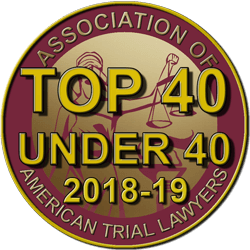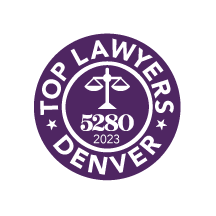Colfax Avenue started as a major thoroughfare through Denver during the Gold Rush. It later became part of US-40, running over 3,000 miles from Atlantic City, NJ, to San Francisco, CA. It was the best way to get across the state of Colorado before the interstate system was born. It first appeared on Denver maps in 1868, named for U.S. House Speaker Schuyler Colfax, who would later become Ulysses S. Grant’s Vice President. In the 1950s, it was booming with tourism and even had a street trolley. However, after Interstate 70 was built, Colfax saw a significant decline in tourism and traffic, paving the way for increased ruin and crime.
While these issues aren’t as significant as they once were, and Colfax Avenue isn’t as busy as it once was, this major Denver street still sees more than its fair share of motor vehicle accidents. Far too many people have suffered injuries or lost their lives in car accidents on this street. If you or a loved one are one of them, don’t delay contacting an experienced Denver car accident attorney to secure your rights.
Types of Car Accidents on Colfax Avenue
All types of car accidents can and have happened on Colfax Avenue in Denver, including the following:
Side-Impact Collisions
Side-impact collisions, commonly called T-bone or broadside accidents, occur when the front of one vehicle collides with the side of another. These collisions pose a significant threat to the vehicle’s occupants struck on its side, as the side of a vehicle is inherently less equipped to absorb impact forces due to its design and structure.
These accidents account for 25 percent of all motor vehicle fatalities annually, often occurring at intersections where drivers disregard stop signs or run red lights. Distraction, impairment, and reckless driving significantly elevate the risk of causing a side-impact collision, which can result in severe injuries even at lower speeds.
Sideswipe Accidents
 Sideswipe accidents occur when two vehicles travel parallel to each other, and one vehicle makes contact with the side of the other. Frequently caused by drivers neglecting to check their blind spots before merging or changing lanes, these accidents can also result from speeding, inattention, recklessness, distraction, or impairment.
Sideswipe accidents occur when two vehicles travel parallel to each other, and one vehicle makes contact with the side of the other. Frequently caused by drivers neglecting to check their blind spots before merging or changing lanes, these accidents can also result from speeding, inattention, recklessness, distraction, or impairment.
Despite their seemingly minor nature, sideswipe accidents are worrisome, as the initial impact may lead to loss of control for one or both vehicles, potentially causing them to veer off the road or into other traffic lanes. Such scenarios can result in collisions with other vehicles, cyclists, pedestrians, or objects alongside the road.
Injuries resulting from sideswipe accidents can be severe, especially with a secondary impact, such as colliding with another vehicle or a stationary object after the initial crash. Common injuries include whiplash, soft tissue injuries, broken bones, internal organ damage, spinal cord injuries (SCI), and head injuries, including traumatic brain injuries (TBI).
Single-Vehicle Crashes
Single-vehicle crashes, more prevalent than commonly thought, often occur when a vehicle collides with an obstruction in its path, such as dropped cargo, an animal, or road debris. Hazards may force the vehicle off the road, leading to collisions with light poles, guardrails, or other obstacles, with the potential for rollovers or entry into ditches.
While involving only one vehicle, these accidents can result in severe injuries if the vehicle collides with a large or heavy object or experiences a rollover. Causes of single-vehicle accidents include adverse weather or road conditions and encounters with animals on the road. Negligence on the part of others, such as poorly designed roads or reckless driving, can also contribute to such incidents.
Rear-End Collisions
Rear-end collisions typically occur when drivers fail to maintain attention on the road or follow the vehicle in front too closely. Insufficient distance between vehicles prevents the rear driver from slowing down or stopping in time to avoid an accident if the leading vehicle unexpectedly halts. Contributing factors to rear-end collisions include distracted driving, drowsy driving, driving under the influence, and speeding.
While the rear driver is often presumed at fault for following too closely, the leading driver may be responsible if they abruptly stop in an active traffic lane or engage in a sudden reversal. Injuries resulting from rear-end collisions can range from minor to catastrophic, with even low-speed accidents causing fractures, neck injuries like whiplash, or more severe damage to the spinal cord.
Frontal Collisions
Frontal collisions, also called head-on collisions, are less frequent than other types of crashes but rank among the most dangerous. As both vehicles approach each other, the resulting impact is intensified, leading to more severe injuries and extensive property damage. While constituting only 11 percent of all fatal crashes, frontal collisions contribute to a staggering 57 percent of all traffic-related fatalities.
Many of these accidents result from the negligence of motorists who drift into oncoming traffic. Factors such as reckless driving, speeding, drug or alcohol impairment, drowsiness, and distraction can all contribute to the occurrence of a frontal collision. Sometimes, even simple factors like confusion in construction zones or navigating highways on and off ramps can lead to these devastating accidents.
Multiple-Vehicle Incidents
While most traffic accidents involve only two vehicles, injuries are prevalent in multi-car pileups involving three or more vehicles. Multi-vehicle accidents often lead to substantial insurance payouts due to the common occurrence of severe injuries and fatalities. In these situations, multiple victims may file claims with various insurance companies, including personal and commercial policies. However, the limited available compensation may pose challenges. To ensure you receive the rightful compensation, it’s crucial to have a qualified car accident attorney representing your claim.
Pedestrian Accidents on Colfax
Colfax does not only see a lot of motor vehicle traffic but also hosts many pedestrians. Unfortunately, these pedestrians are just as at risk, if not more, for being involved in an accident on this street. Car accidents involving pedestrians occur on this street for many reasons, including the following:
- Distracted Driving: Drivers using cell phones, adjusting music, or otherwise distracted may not notice pedestrians, leading to accidents.
- Speeding: Speeding reduces a driver’s reaction time and can potentially increase the severity of injuries in a collision with a pedestrian.
- Failure to Yield: Drivers not yielding the right of way to pedestrians, especially at crosswalks or intersections, can result in accidents.
- Impaired Driving: Getting behind the wheel while under the influence of alcohol or drugs impairs a driver’s judgment and coordination, increasing the risk of accidents involving pedestrians.
- Poor Visibility: Low visibility conditions, such as inadequate street lighting or bad weather, can make it tricky for drivers to see pedestrians and vice versa.
- Drowsy Driving: Fatigued drivers may have slower reaction times, reduced alertness, and impaired judgment, contributing to pedestrian accidents.
- Ignoring Traffic Signals: Failure of both drivers and pedestrians to obey traffic signals and signs can lead to collisions.
- Inadequate Infrastructure: Poorly designed or maintained roads, sidewalks, and crosswalks can contribute to accidents by creating pedestrian hazards.
- Reckless Driving: Aggressive driving behaviors, such as running red lights or aggressive maneuvers, pose a threat to pedestrians.
- Driver Inattention: Ignoring the road and surroundings can result in drivers not seeing pedestrians until it’s too late to avoid a collision.
- Vehicle Blind Spots: Pedestrians can be at risk when crossing near large vehicles with significant blind spots where drivers may not see them.
- Unmarked Crosswalks: Lack of proper marking for crosswalks can confuse drivers and pedestrians, increasing the likelihood of accidents.
- Poorly Timed Traffic Lights: Traffic signals with inadequate timing for pedestrian crossings may lead to conflicts between pedestrians and turning vehicles.
Can You Sue the City of Denver if You Suffer Injuries in an Accident on Colfax Avenue?
Yes, it is possible to sue the City of Denver for a car accident under certain circumstances. Suppose the accident results from the city’s failure to maintain the road in a reasonable condition. In that case, the injured party can file an injury claim against the city seeking damages based on Colorado’s negligence laws.
Although the City of Denver is generally immune from lawsuits, there are exceptions outlined in the Colorado Governmental Immunity Act. According to Colorado Revised Statutes 24-10-103, the governmental immunity law is in effect. However, Colorado Revised Statutes 24-10-106 specifies that the city waives its immunity in cases of negligence and premises liability when it allows a dangerous condition to exist. This waiver enables individuals to pursue legal action against the city for such incidents.
Car Accident Claims Against the Government
The Federal Tort Claims Act and various state and local statutes empower individuals to pursue legal action against the government in the event of car accidents. Claims involving government employees or entities differ somewhat from standard claims. If your lawyer determines that filing a claim against the government is necessary for your car accident case, you must follow specific procedures. Therefore, it is a good idea to enlist the assistance of a skilled Denver car accident lawyer who is familiar with handling such cases.
Although the details and deadlines may vary across states or jurisdictions, initiating claims against the government typically involves submitting a “notice of claim” to the relevant agency’s office. Typically, you file a notice of claim by using a government-published claim form, including sections for:
- Your name and address
- Identification of the government entity responsible for your damages
- A detailed account of when, where, and how the injuries occurred
- A comprehensive description of injury damages, such as medical costs, lost income, and pain and suffering
- Your written intent to seek financial compensation for injuries resulting from the negligence of the government agency or its employee
- The monetary amount sought for your damages
Your car accident attorney will know the deadline for submitting a notice of claim, usually ranging from a few months to a year after the injury occurs. Always contact an experienced car accident lawyer promptly after the accident to increase the likelihood of a successful claim. Failure to meet the deadline for filing a notice of claim significantly reduces the chances of obtaining compensation for injuries. Your car accident lawyer will handle the notice of claim on your behalf, allowing you to concentrate on recovering from your injuries.
Once your lawyer files the notice of claim, they may receive a response from an insurance adjuster representing the government entity. Subsequently, your car accident attorney will aim to negotiate a fair settlement for your damages. If negotiations are unsuccessful, you have the option to proceed with litigation. While most accident cases are resolved through settlements, some may go to court. In any case, your attorney will tirelessly work to secure the compensation you rightfully deserve.
How a Lawyer Can Help After a Car Accident on Colfax Avenue in Denver
If you’re involved in a car accident on Colfax Avenue in Denver, hiring a lawyer can be beneficial in several ways:
- Legal Knowledge and Experience: A lawyer who regularly handles car accident claims will have a deep understanding of the relevant laws, regulations, and legal processes specific to Denver and Colorado. They can help you understand how these laws apply to your case.
- Investigation: Attorneys can thoroughly investigate the circumstances surrounding the accident. This may involve collecting evidence, obtaining witness statements, reviewing police reports, and working with accident reconstruction experts to determine liability.
- Communication with Insurance Companies: Dealing with insurance companies can be complex. A lawyer can handle communication with insurance adjusters, ensuring that the insurance company respects your rights and doesn’t take advantage of you by offering a lower settlement than you deserve.
- Negotiating a Fair Settlement: Lawyers are skilled negotiators. They can negotiate with the at-fault party’s insurance company to reach a fair settlement. If you cannot reach a satisfactory, your lawyer may advise taking the case to court.
- Navigating the Legal Process: If your case goes to court, a lawyer will guide you through the legal process, ensuring all necessary paperwork is filed correctly and within deadlines. They will present your case in court, advocating for your rights and seeking the compensation you deserve.
- Providing Peace of Mind: Dealing with the aftermath of a car accident can be stressful. Having a lawyer can provide peace of mind, knowing that a legal professional is handling the complexities of your case and working to secure the best possible outcome while you rest and recover from your injuries.
If you have suffered injuries in a car accident on Colfax Avenue in Denver, it’s crucial to consult with a qualified personal injury attorney in Denver who can assess the specifics of your case and provide detailed legal advice specific to your circumstances.




















